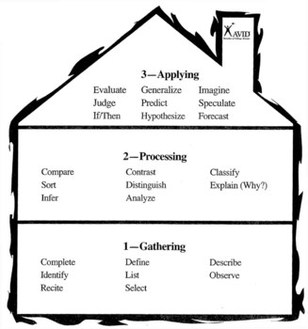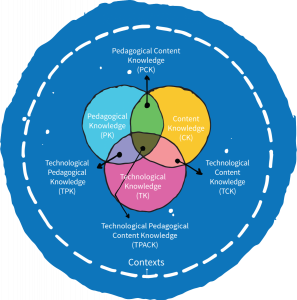It’s been an exciting week for me with respect to my academic and professional journey. My focus for my master’s project has shifted, I have been inspired in my practice to re-evaluate my pedagogy with renewed intention of meeting my learners’ needs, and I have considered two new models that can significantly contribute to the development and evaluation of using technology in my teaching practice.
My original question for my educational research was centered around how collaborative practices can influence student engagement. While reading Voogt, et al. (2018) and their chapter titled “Developing an Understanding of the Impact of Digital Technologies on Teaching and Learning in an Ever-Changing Landscape” from the Second Handbook of Information Technology in Primary and Secondary Education, I was introduced to research regarding the contributions of technology to formal and informal learning. I am excited at the potential for this area of research to inform and guide my interest on how technology can facilitate and transform the learning environment for my students in Environmental Science. I am excited to pursue the research on formal and informal learning, to consider how this can contribute to lifelong learning, and to utilize the TPACK and SAMR models as frameworks from which I can plan, support, and evaluate the use of technology in my teaching practice.
As a trained AVID teacher, I have built my teaching practice upon the goals of encouraging and facilitating critical thinking in my students. 
I begin every class I teach with a lesson on Costa’s framework for higher level thinking, followed by practice developing and recognizing higher level questions. It is an underlying and constant theme in my classes to encourage students to engage in higher level thinking and questioning, and it is through this lens of higher level thinking that I have come to appreciate and process the information I have read this week on TPACK and SAMR.
I view both models as valuable tools for informing my teaching with respect to the use of technology, however they are unique in their potential contributions and shortcomings. I will outline each of the models, summarize their key strengths and weaknesses, and consider how each model facilitates critical thinking of technology use in the classroom.
TPACK: Technological Pedagogical Content Knowledge
I appreciate the TPACK model as outlined by Koehler and Mishra (2009) for the elegant framework it provides educators to analyze their teaching practice from the three areas of content knowledge, technology, and pedagogy. This model is refreshing as it recognizes the importance of these three individual skill-sets, and then encourages the educator to improve and grow in their practice by considering how these skill-sets interact and complement each other. Ultimately, the TPACK model is easy to use and student-centered, prompting the educator to be intentional in their planning. As I am a linear thinker, I found myself wanting to order the skill-sets from foundational to that of highest development, much like Costa’s levels of thinking. That being said, I have come to value the holistic representation of the TPACK model as it honors the complexities of teaching and learning. I recognize that the development of an educator is not linear, and I am reminded by the TPACK model that I will continually need to analyze and adjust my practice with respect to these three cornerstones of teaching.

Image based on the original on TPACK.org
The TPACK model is quite simple in its presentation, vocabulary, and application. For this reason, I believe the TPACK model is favorable over the SAMR model for professional development opportunities within schools. It is general enough to allow all teachers to identify their unique strengths and consider technology from a new perspective in order to work towards more effective and meaningful technology use in the classroom.
Perhaps a shortcoming of this model is that it appears to be teacher centered and focused on lesson development. As with all strong pedagogical practices, one must remain student-centered in their lesson development, implementation, and evaluation.
SAMR: Substitution, Augmentation, Modification, Redefinition

Image Modified from Original by Lefflerd’s on Wikimedia Commons
The SAMR model is specific to mobile devices rather than technology as a whole, and appears to be more prescriptive and specific than the TPACK model. Whereas the TPACK model emphasized the importance and interactions between technology, content and pedagogy, the SAMR model is intended to be “used to classify and evaluate mLearning activities” Romrell, et al., (2014). I believe focusing on mLearning is a limiting view of educational and learning, as it simplifies the complexity of teaching by omitting the important aspects of content and pedagogy from the model. For the inexperienced teacher, it may lead to frustration as they work to integrate technology without adequate consideration of content, pedagogy, and the appropriateness of using technology. For these reasons, the SAMR model may be met with skepticism if it were utilized for school-wide professional development as teachers may be resistant to technology being a focus rather than an aspect of effective lesson planning and development.
The SAMR model is presented in a linear manner, and resembles that of Costa’s house of higher learning as pictured above. It appears that the introduction of technology might progress from substitution to augmentation, to modification and finally to redefinition but I believe this places unnecessary limitations on the model. By being represented as a taxonomy the focus is directed away from the process and towards the final product. Viewing the levels as separately rather than a progression can help the educator be intentional about their use of technology and assess their lessons while looking for new and innovative uses of mobile devices. The SAMR model is gaining momentum, but it is still a relatively recent framework that has inconsistent representations on the internet that might complicate its productive application (Hamilton, Rosenberg & Akcaoglu, 2016). Hamilton, et al.’s article also outlines three potential challenges of the framework, namely an absence of context, a rigid structure, and that it emphasizes product over process.
A strength of the SAMR model is the identification of three key characteristics of mobile devices: they are personal, situated and connected. It is these three characteristics of mobile technology that have the potential to redefine learning for my Environmental Science students. In fact, the analysis conducted by Romrell et al. (2014) found that
If learning activities involving a mobile device are purposefully designed to be personalized, situated, and connected, the resulting mLearning activities have the potential to redefine and transform learning.
My hopes for my students include that they might build on their experiences with social media to create a PLN that will contribute to global collaboration and awareness of environmental issues. With technology, students have the ability to influence global audiences through the construction of blogs and videos and they can produce artifacts as evidence of critical and higher level thinking (application of knowledge) that can have a global impact.
Twenty years ago when I started teaching my strengths were in the content areas of Math and Biology. Almost 10 years ago, I had the privilege of participating in three consecutive years of AVID training which significantly enhanced my pedagogical practice. Recently I have embarked on being intentional about the use of technology with my students. I appreciate the TPACK model for honoring the three contributing aspects of my practice (content, pedagogy and technology) and their interactions as I consider how I can incorporate technology effectively. The SAMR model provides me with a framework that will facilitate a critical analysis of the use of technology in my teaching practices and how it contributes to learning. Even though the content area I teach may change and technology continues to evolve, my ultimate goal for myself and my students remains the same – to become higher level questioners and thinkers. It is as a critical thinker that I approach models such as SAMR and TPACK and identify ideas and inspiration that will help guide my teaching practice and facilitate transformational learning.
Additional articles to read re: Formal and Informal Learning
Cochrane, T.D. (2012). Secrets of mlearning failures: Confronting reality. Research in Learning Technology, 5 (2012 Conference Proceedings – A confrontation with reality), 123-134.
Cornelius, S., Marston, P., & Gemmell, A. (2011). SMS text messaging for real-time simulations in higher education. In J. Traxler & J. Wishart (Eds.), Making mobile learning work: Case studies of practice, 13-17.
Pfeiffer, V. D. I., Gemballa, S., Jarodzha, H., Scheiter, K., & Gerjets, P. (2009). Situated learning in the mobile age: Mobile devices on a field trip to the sea. Research in Learning Technology, 17(3), 187-199.
Traxler, J. (2010). Students and mobile devices. Research in Learning Technology, 18(2), 149-160
Rene Schwarz says:
You have such a positive view of the literature and I sometimes wonder if I am becoming a curmudgeon, but as with everyone, our experiences, culture, and training inform how different our approaches can be. You pointed out TPACK as being a little teacher-centred. You also use the product critique in SAMR. How are their end results different? What kind of technology do you envision evaluating using either of these models? What do the models justify? – pedagogy and product? To what end?
September 22, 2019 — 11:07 pm